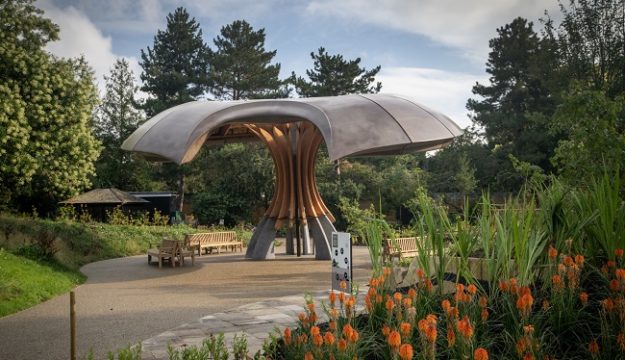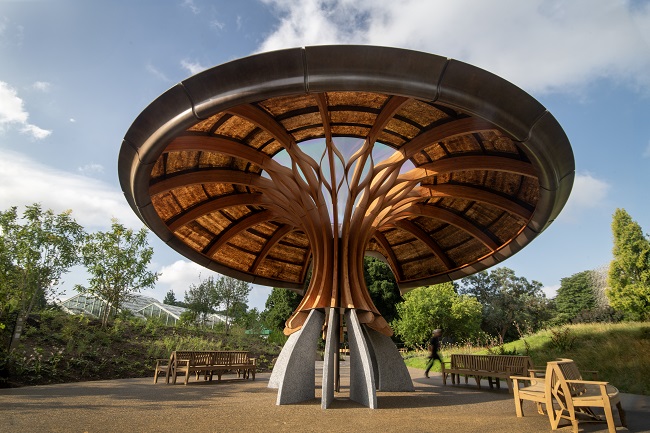 Image by Jeff Eden © RBG Kew
Image by Jeff Eden © RBG Kew
- New, permanent garden opens at Kew Gardens, with 35 new trees and 6500 plants
- The original design tells the story of carbon, the scale of the climate crisis and positions plants and fungi as our natural allies
- Stunning central Pavilion inspired by fungi and made with natural materials
- The Carbon Garden encourages visitors to become advocates for nature
- Entry to the Carbon Garden is free with a ticket to Kew Gardens
- Garden made possible by Biffa Award funding and players of People’s Postcode Lottery
On Friday, 25 July 2025, Kew Gardens in London opened one of its most ambitious garden projects in recent years: the Carbon Garden. Through beautiful planting and innovative design, this new permanent garden brings to life the critical role carbon plays in sustaining life on Earth, communicates the scale of the climate crisis, and shares the extraordinary potential of plants and fungi to combat it.
What is carbon?
Quite literally ‘stardust’, carbon is the building block of life – it can be found in all living things. It exists in the air, it is dissolved into our oceans and rivers, it is found in organic matter in soils and is stored deep underground in sedimentary rocks and fossil fuels (99% of carbon on Earth is stored underground). However, the balance has been upset, and human activities are releasing too much carbon dioxide into the atmosphere, trapping heat and warming the planet. Plants and fungi are our natural allies in climate repair and hold the power to capture carbon and restore balance.
The Carbon Garden
A curated selection of herbaceous perennials take inspiration from Reading University’s climate stripes, illustrating the dramatic rise in global average temperatures over time. Plant highlights include Achillea ‘Moonshine’, ‘Paprika’ and ‘Red Velvet’, and Hydrangea serrata ‘Bluebird’. This powerful visual statement welcomes visitors into the garden alongside an exposed coal seam showing fossilized plants, highlighting the connection between plants and fossil fuels.
Delving into links between carbon emissions and climate change, a dry garden begins to showcase ways we can work together with plants to adapt to a changing climate. Here, drought-tolerant plants such as Parry’s agave (Agave parryi) and lavendar dominate, illustrative of the plants we might look to for London gardens in 30 years.
Nature offers hope through its extraordinary capacity to sequester and lock in carbon. 35 new trees have been selected for their resilience to projected future climate conditions. Trees play a critical role in helping urban areas adapt to climate change thanks to the myriad of ecosystem services they offer, including absorption of carbon dioxide, shade and shelter provision, and improvement of air quality by filtering out pollutants.
A rain garden illustrates ways we can manage water flow, prevent soil erosion, reduce flooding, recharge moisture into the soil and support moisture-tolerant plants that maintain soil stability and carbon storage. Grasslands, wildflower meadows and native hedgerows will boost biodiversity and lock in carbon, as biodiverse habitats are more resilient and better at storing carbon than monocultures.

Image by Jeff Eden © RBG Kew
Appearing to grow from the centre of the Carbon Garden as a symbolic fungal fruiting body is a pavilion designed by Mizzi Studio. Inspired by the symbiotic relationship between plants and fungi, the materials and structure have been modelled on biological processes, and the pavilion has been created using natural materials. A forward-tilted canopy directs rainwater into the rain garden, and the sheltered space will support school visits and community activities. The Carbon Garden encourages visitors to become advocates for nature, highlighting actions we can all take in our everyday lives to support the health of plants and the planet.
Richard Wilford, designer of the Carbon Garden and Manager of Garden Design at RBG Kew says:
‘The Carbon Garden offers a unique opportunity to showcase our ongoing research, combining scientific insight with thoughtful design and beautiful planting to highlight the role of carbon in our lives, how it moves through the environment and how plants and fungi can help us tackle climate change. We hope the Carbon Garden inspires visitors to act and join us in shaping a more sustainable, resilient future for life on our planet.’
Kew Science and Horticulture
With over 500 scientists and 150 horticulturists working with partner institutions worldwide, RBG Kew works at the nexus between climate change, biodiversity, and sustainable development, leading cutting-edge research into carbon capture and the role plants play in mitigating climate change. Kew scientists are assessing the carbon-capture potential of various species and ecosystems, including grasslands, hedgerows and woodlands. Early findings have revealed higher volumes of carbon are being sequestered than initially thought, highlighting the importance of these ecosystems. This research aims to inform conservation strategies and land management practices.
Simultaneously, horticulturists and arboriculturists at Kew Gardens are researching the trees of the future, using Kew’s 11,000 trees to assess species resilience. These projects are working to determine which plants will not only thrive in a changing climate but also mitigate the effects of the climate crisis.
The Carbon Garden has been made possible thanks to funding from Biffa Award through the Landfill Communities Fund, funds raised by players of People’s Postcode Lottery, and generous philanthropy and donations.
Rachel Maidment, Biffa Award Grants Manager, says: ‘We are immensely proud to support the Carbon Garden, which will educate and inspire visitors about the vital role of carbon in our environment. Through the Landfill Communities Fund, we are committed to funding projects that have a lasting positive impact on both people and the planet. We are particularly excited that this garden will not only showcase Kew’s research but will also serve as a hub for learning, demonstrating how collective action can drive real environmental change. Biffa Award is honoured to play a role in bringing this vision to life.’
Laura Chow, Head of Charities at People’s Postcode Lottery says, ‘RBG Kew’s new Carbon Garden is a fantastic example of how support from players of People’s Postcode Lottery is driving positive change for the planet. It is because of them that this innovative project can be brought to life, inspiring people to come together to learn more about the world we live in and protect nature for generations to come.’
Opened Friday 25 July 2025, the Carbon Garden is a must-see attraction this summer at Kew Gardens which is celebrating everything that is wonderful about trees. Alongside The Power of Trees exhibition in the Shirley Sherwood Gallery of Botanical Art, and Of the Oak, an inspiring outdoor installation by Marshmallow Laser Feast which explores the secrets of Kew’s magnificent Lucombe Oak, there are a host of ways to enjoy the wonder of Kew’s collections.





